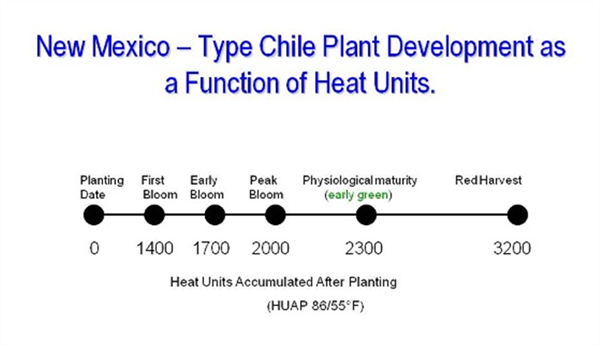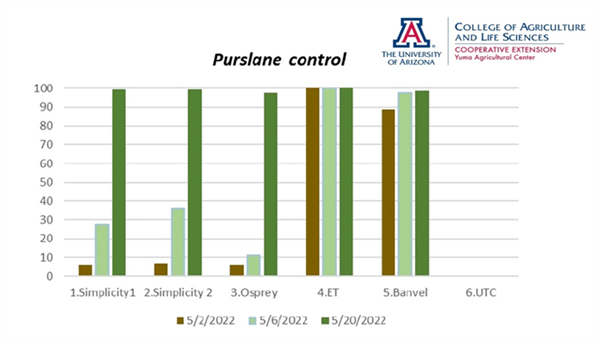Jun 14, 2023
Crop Growth, Development, Nutrient, and Water Demand for Irrigated Chile (Capsicum annuum) (2023)
Southwestern Chile Production
Chile (Capsicum annuum) production is an important aspect of vegetable crop production systems in the desert Southwest. In many respects, chiles are a trademark feature of crop production in the desert Southwest. The Southwestern (SW) Chile Belt extends from southeast Arizona, across southern New Mexico, into far-west Texas, and northern Chihuahua, Mexico. The SW Chile Belt is dominated by production of New Mexico-type chile, also commonly referred to as “Hatch chile” and sometimes referred to as “Anaheim” type chile.
Recent acreages across the SW Chile Belt have consisted of approximately 7-8,000 acres in NM, 3-4,000 in TX, approximately 90,000 acres in Chihuahua, and about 300-500 acres in Arizona. Chiles are often associated with New Mexico, but Arizona also has a strong connection to this chile industry. For example, the Curry Chile Seed Company, based in Pearce, AZ, provides the seed for >90% of the total green chile acreage across the SW Chile Belt.
Chile peppers (Capsicum species) are among the first crops domesticated in the Western Hemisphere about 10,000 BCE (Perry et al., 2007). The Capsicum genus became important to people and as result, five different Capsicum species that were independently domesticated in various regions of the Americas (Bosland &Votava, 2012). Early domestication of chile peppers by indigenous peoples was commonly driven for use as medicinal plants. Due to their flavor and heat characteristics, chile peppers are a populate food ingredient in many parts of the world, including Latin America, Africa, and Asia cuisines. Chiles have been increasingly important to the U.S. and European food industries, particularly as these populations become more familiar with chile (Guzman and Bosland, 2017).
There are five domesticated species of chile peppers. 1) Capsicum annuum is probably the most common to us and it includes many common varieties such as bell peppers, wax, cayenne, jalapeños, Thai peppers, chiltepin, and all forms of New Mexico chile. 2) Capsicum frutescens includes malagueta, tabasco, piri piri, and Malawian Kambuzi. 3)Capsicum chinense includes what many consider the hottest peppers such as the naga, habanero, Datil, and Scotch bonnet. 4) Capsicum pubescens includes the South American rocoto peppers. 5) Capsicum baccatum includes the South American aji peppers.
The Capsicum annuum species is the most common group of chiles that we encounter and there are at least 14 very different pod types in this single species that includes: New Mexico (aka Anaheim), bell peppers, cayennes, jalapeños, paprika, serrano, pequin, pimiento, yellow wax, tomato, cherry, cascabel, ancho (mulato, pasilla), and guajillo (Guzman and Bosland, 2017).
Crop Phenology
Plants vary tremendously in their physiological behavior over the course of their life cycles. As plants change physiologically and morphologically through their various stages of growth, water and nutritional requirements will change considerably as well. Efficient management of a crop requires an understanding of the relationship between morphological and physiological changes that are taking place and the input requirements.
Heat units (HUs) can be used as a management tool for more efficient timing of irrigation and nutrient inputs to crop and pest management strategies. Plants will develop over a range of temperatures which is defined by the lower and upper temperature thresholds for growth (Figure 1). Heat unit systems consider the elapsed time that local temperatures fall within the set upper and lower temperature thresholds and thereby provide an estimate of the expected rate of development for the crop. Heat unit systems have largely replaced days after planting in crop phenology models because they take into account day-to-day fluctuations in temperature. Phenology models describe how crop growth and development are impacted by weather and climate and provide an effective way to standardize crop growth and development among different years and across many locations (Baskerville and Emin, 1969; Brown, 1989).
The use of HU-based phenology models are particularly important and applicable in irrigated crop production systems where water is a non-limiting factor. Water stress will alter phenological plant development and it is a major source of variation in crop development models. Accordingly, irrigated systems are more consistent in crop development patterns and HU models can be much more consistent and reliable.
Chiles are a warm season, perennial plant with an indeterminant growth habit that we grow and manage as an annual crop. The fruiting cycle begins at the crown stage of growth and continues until the plant reaches a point of “cut-out” with hiatus in blooming as the plant works to mature the chile fruit crop that has been developed.
The first step in developing a phenological guideline for chiles would be to look for critical stages of growth in relation to HU accumulation. Figure 2 describes the basic phenological baseline for New Mexico – type chile and was developed from field studies conducted in New Mexico and Arizona (Silvertooth et al., 2010 and 2011; Soto et al., 2006; and Soto and Silvertooth, 2007).
Water and nutrient demands coincide with the fruiting cycle and efficient management of irrigation water and plant nutrients is enhanced by tracking crop development in the field. The use of HUs (86/55 oF thresholds) can be applied since the thermal environment impacts the development of all crop systems, including chiles, (Figures 2 and 3).
Use of HUs to predict chile development is generally superior to using days after planting due to the simple fact that the crop responds to environmental conditions and not calendar days. This approach, using phenological timelines or baselines, works best for irrigated conditions where crop vigor and environmental growth conditions are more consistent than in non-irrigated or dryland situations where irregularity in year-to-year rainfall patterns can alter growth and development patterns significantly. Accordingly, water stress in an irrigation system will alter phenological plant development and usually accelerate crop maturity and create an earlier crop and increase fruit abortion or cause smaller fruit development.
Crop Phenology Relationship to Nutrient and Water Demand
Phenological guidelines can be used to identify or predict important stages of crop development that impact physiological requirements. For example, a phenological guideline can help identify stages of growth in relation to crop water use (consumptive use) and nutrient uptake patterns. This information allows growers to improve the timing of water and nutrient inputs to improve production efficiency. For some crops or production situations HU based phenological guidelines can be used to project critical dates such as harvest or crop termination. Many other applications related to crop management (e.g., pest management) can be derived from a better understanding of crop growth and development patterns.

Figure 1. Typical relationship between the rate of plant growth and development and temperature. Growth and development ceases when temperatures decline below the lower temperature threshold (A) or increase above the upper temperature threshold (C). Growth and development increases rapidly when temperatures fall between the lower and upper temperature thresholds (B).

Figure 2. Basic phenological guideline for irrigated New Mexico-type chiles.

References
Baskerville, G.L. and P. Emin. 1969. Rapid estimation of heat accumulation from maximum and minimum temperatures. Ecology 50:514-517.
Bosland, P.W., E.J. Votava, and E.M. Votava. 2012. Peppers: Vegetable and spice capsicums. Wallingford, U.K.: CAB Intl.
Brown, P. W. 1989. Heat units. Bull. 8915, Univ. of Arizona Cooperative Extension, College of Ag., Tucson, AZ.
Guzmán, I. and P.W. Bosland. 2017. Sensory properties of chile pepper heat - and its importance to food quality and cultural preference. Appetite, 2017 Oct 1;117:186-190. doi: 10.1016/j.appet.2017.06.026.
Perry, L., Dickau, R., Zarrillo, S., Holst, I., Pearsall, D. M., Piperno, D. R., et al. 2007. Starch fossils and the domestication and dispersal of chili peppers (Capsicum spp. L.) in the Americas. Science, 315, 986-988.
Silvertooth, J.C., P.W. Brown, and S. Walker. 2010. Crop Growth and Development for Irrigated Chile (Capsicum annuum). University of Arizona Cooperative Extension Bulletin No. AZ 1529
Silvertooth, J.C., P.W. Brown and S.Walker. 2011. Crop Growth and Development for Irrigated Chile (Capsicum annuum). New Mexico Chile Association, Report 32. New Mexico State University, College of Agriculture, Consumer and Environmental Science.
Soto-Ortiz, Roberto, J.C. Silvertooth, and A. Galadima. 2006. Crop Phenology for Irrigated Chiles (Capsicum annuum L.) in Arizona and New Mexico. Vegetable Report, College of Agriculture and Life Sciences Report Series P-144, November, University of Arizona.
Soto-Ortiz, R. and J.C. Silvertooth. 2007. A Crop Phenology Model for Irrigated New Mexico Chile (Capsicum annuum L.) The 2007 Vegetable Report. Jan 08:104-122.
 To contact John Palumbo go to: jpalumbo@ag.Arizona.edu
To contact John Palumbo go to: jpalumbo@ag.Arizona.edu












